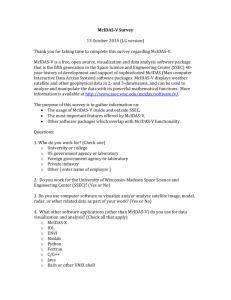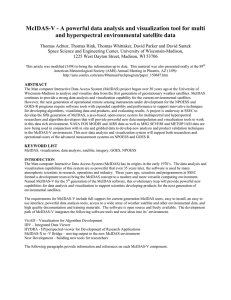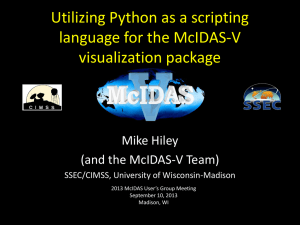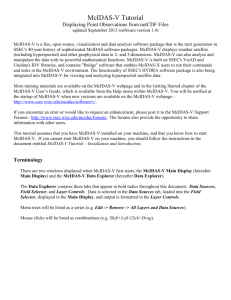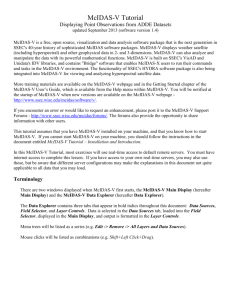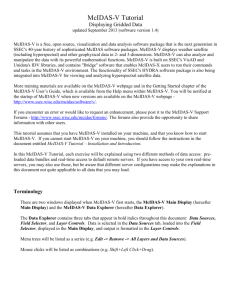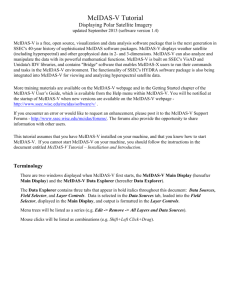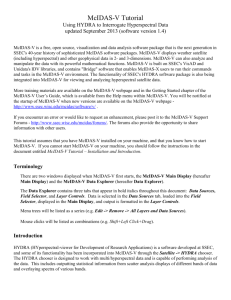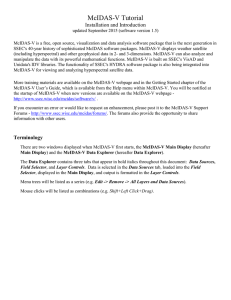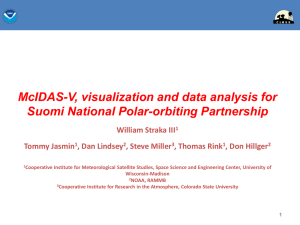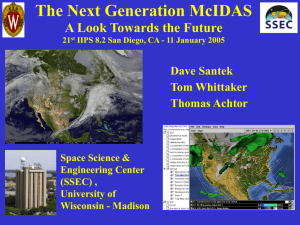McIDAS Transition Summary - SSEC
advertisement
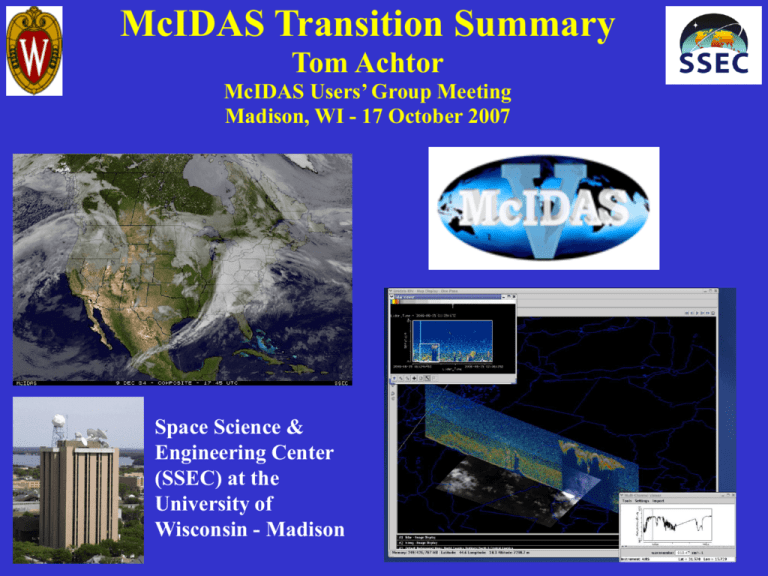
McIDAS Transition Summary Tom Achtor McIDAS Users’ Group Meeting Madison, WI - 17 October 2007 Space Science & Engineering Center (SSEC) at the University of Wisconsin - Madison Interactive Processing of Multi- and Hyper-spectral Environmental Satellite Data: The Next Generation of McIDAS SPIE San Diego, CA - 28 August 2007 Tom Achtor, Tom Rink, Tom Whittaker Space Science & Engineering Center (SSEC) at the University of Wisconsin - Madison McIDAS-V Conference Presentations • AMS IIPS - 2005, 2006, 2007, 2008 • AMS Sat Met - 2007 • AGU Fall Mtg – 2005, 2007 • SPIE - 2007 Outline • The heritage of McIDAS-X • What is McIDAS-V – VisAD – IDV • Developing powerful McIDAS-V Components for future observing systems – HYDRA – X to V ‘bridge’ – Proxy/Origami/GEOCAT • Supporting NPOESS and GOES R Transition to McIDAS-V • McIDAS nearly 35 years of development – 1st generation 1973 • Harris/5 computer – 2nd generation 1978 • Harris/6 computers, distributed system – 3rd generation 1984 • IBM mainframe 43xx, OS/2 workstation – 4th generation 1992 • McIDAS-X , Unix environment – 5th generation 2007 • McIDAS-V What is McIDAS-X ? (Man computer Interactive Data Access System) • Collection of user programs and libraries for visualizing and analyzing geophysical data (focus on environmental satellites) – UNIX, PC & Mac capable • A synergistic tool that integrates numerous data types into one system • First developed in the early 1970s • Still in use world-wide at research, operational, educational, and commercial sites Key McIDAS-X Attributes • Access to extensive geophysical database • Core package plus user-written applications • Diverse functionality through software (1 million + lines of code) • Extensive visualization capabilities • Satellite and NOAAPORT data ingest McIDAS-X Functionality • Digital Image Processing • GIS Applications • Weather and Climate Data Analysis and Applications • Graphical Displays of Data & Information • Gridded Data Processing and Analysis Tools • Display & Process Control Utilities • Interactive and Background Processing McIDAS-X Users • NOAA – NESDIS, AWC, SPC, TPC, etc. • NASA – STS, LaRC, MSFC • Unidata – 130 universities, colleges and international collaborators • International – Australia, EUMETSAT, Greece, Kwajalein, Mexico, Spain, etc. • Industry – Honeywell, ImpactWeather, Meteorlogix, Weather Central, Weathernews, WTVT, etc. Why the Change? • Forthcoming GOES-R & NPOESS operational satellite data cannot be optimally utilized – great increase in data rates – new tools for working with these large data sets • McIDAS software (written in Fortran 77 and C) has a 30+ year heritage resulting in limited extensibility potential • New data analysis and visualization concepts cannot be incorporated (e.g. 4-D) Project Requirements • Create a powerful and versatile software system for environmental data processing, analysis and visualization • Support existing and evolving needs of scientific research and algorithm/applications development for new programs • Support data fusion and algorithm interoperability from existing and future sources • Continue to fully support McIDAS Users’ Group (MUG) and McIDAS-X functionality as users transition to McIDAS-V • Support operational users by providing frameworks in McIDAS-V, enabling a natural transition path for research results into operations • Use system to educate students in remote sensing and physical sciences; involve students in its development, evolution and use McIDAS-V Functionality McIDAS-V will be a collection of software tools, and networked services and data designed to take advantage of a scalable distributed computing environment to meet user needs • McIDAS-X • OpenADDE / OPeNDAP • Open GIS Consortium • Database archives • Cluster computing Transition to McIDAS-V • McIDAS-V software built on SSEC’s VisAD and Unidata’s IDV libraries • McIDAS-V 1.0alpha5 just the beginning – Emphasize on user interface – McIDAS-X bridge • McIDAS-V open-source / freely available • McIDAS-V user support available through McIDAS Users’ Group (MUG) McIDAS-V 4 Goals for the MUG Meeting • Easy installation and configuration of McIDAS-V and the McIDAS-X listener • • • New McIDAS-V GUI McIDAS-V must be able to “bridge” with current McIDAS-X Integrate HYDRA (Hyperspectral Viewer for Development of Research Applications) into McIDAS-V What is McIDAS-V McIDAS-X VisAD + IDV + HYDRA = McIDAS-V The “X to V” Bridge • Interacts with a McIDAS-X remote session • Users provides command line input in a McIDAS-V Data Chooser that sends commands to a server running McIDAS-X • Runs all McIDAS-X commands, including status, text, imagery and graphics – McIDAS-X output displayed in McIDAS-V • Allows bi-directional interactive communication between McIDAS-V and McIDAS-X The “X to V” Bridge What is McIDAS-V McIDAS-X VisAD + IDV + HYDRA = McIDAS-V AIRS Cirrus vs Clear Sky Spectra HYDRA RGB composite tool applied to MSG SEVIRI channels. In the above, Band 5 minus Band 6, (6.7micron,7.3micron) is mapped to Red, Band8 minus Band9 (9.7,10.8) is mappped to Green and Band5 is mapped to Red. The latter is inverted using the histogram stretch tool. This composite technique was developed by Eumetsat to emphasize cyclogenesis, jet-streaks and mid vs high-level clouds. McIDAS-V Future Ported McIDAS-X Functionality McIDAS-V GUI HYDRA IDV VisAD McIDAS-X Bridge NEW McIDAS-V Functionality Future Bridges JAVA Servers Other Servers McIDAS-X mctext, mcimage, ADDE servers MUG Packaged OpenADDE, OPeNDAP Data Commands Data Data Other Resources IDL, MATLAB, Origami, Database Access .. McIDAS-V is a collection of software tools, and networked services and data designed to take advantage of a scalable distributed computing environment to meet user needs. GIS Cluster OPeNDAP/ computing ADDE McIDAS-V GEOCAT Database/ McIDAS-X SAN MATLAB/ IDL Origami Experiment Goals • Visualization of meteorological fields from very large simulated model and retrieved data sets • Submit request from web service or McIDAS-V • Remotely query a large database to obtain the required data and load into an application or task • Invoke the task on a cluster computer, reading from the database and writing results to a temporary file • Inform the user where the output data resides and bring results into McIDAS-V The Origami Experiment GEOCAT Conceptual Model -Satellite Images -Ancillary Data GEOCAT L1 (radiances) L2 (pixel-level products) RTM (clear radiances) Calibrated/navigated radiances and ancillary data are loaded into data structures that can be accessed by algorithms Navigation and Calibration Map ancillary data to pixel level Execute higher order algorithms Calculate clear sky radiances (if needed) Execute lower order algorithms Output from high order algorithms is available to lower level algorithms GEOCAT - McIDAS-V Link • McIDAS-V can readily access services following emerging standards for distributed application systems. • For algorithm testing on large proxy, simulation and real datasets, the GEOCAT test framework can be distributed on computing clusters. • A toolset for submitting large GEOCAT calculations and directly displaying output in McIDAS-V will allow increased productivity for algorithm developers. McIDAS-V Funding • MUG is providing support for the “Bridge” and the GUI • The IPO and GOES R Risk Reduction are supporting the integration of HYDRA • The NASA PEATE project is providing some design support • The GOES R Algorithm Working Group will provide development funds to support multi and hyperspectral data analysis McIDAS-V Future Work • Complete HYDRA integration • Complete development of the ‘X to V Bridge’ to provide an evolutionary path for MUG into McIDAS-V (October 2007) – Beta 1.0 release forthcoming (early 2008) • Support the development of applications for the NPP/NPOESS and GOES R science teams (ongoing) – Data management and accessibility – Broad array of formats and services – Advanced analysis and visualization tools McIDAS-V • Next Areas for Development McIDAS-V, without the bridge, must access and output other types of data already available in McIDAS-X – – – – Display local and remote image datasets including archived satellite imagery Plot and contour local and remote McIDAS grid datasets Contour remote datasets and contour and plot local McIDAS point datasets Save the digital data file(s) generated in above McIDAS-V Contributors McIDAS-X VisAD/IDV/HYDRA Origami/GEOCAT Kevin Baggett Jon Beavers Gail Dengel Rick Kohrs Dave Parker Becky Schaffer Jessica Staude Tom Whittaker Tom Rink Bruce Flynn Ray Garcia Maciek S-O Mike Pavolonis Don Murray Jeff McWhirter Bob Knuteson Bill Hibbard McIDAS Transition Summary Tom Achtor McIDAS Users’ Group Meeting Madison, WI - 17 October 2007 Space Science & Engineering Center (SSEC) at the University of Wisconsin - Madison
